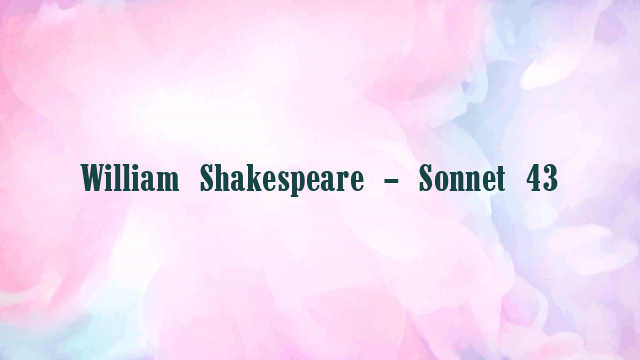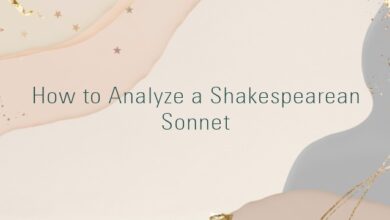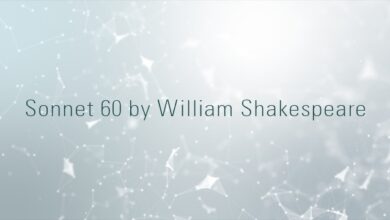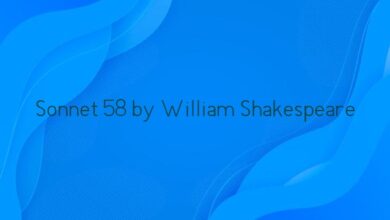
When most I wink, then do mine eyes best see,
For all the day they view things unrespected;
But when I sleep, in dreams they look on thee,
And darkly bright, are bright in dark directed.
Then thou, whose shadow shadows doth make bright,
How would thy shadow’s form form happy show
To the clear day with thy much clearer light,
When to unseeing eyes thy shade shines so!
How would, I say, mine eyes be blessed made
By looking on thee in the living day,
When in dead night thy fair imperfect shade
Through heavy sleep on sightless eyes doth stay!
All days are nights to see till I see thee,
And nights bright days when dreams do show thee me.
After the torment and anguish of betrayal, the poet in this and the following sonnets analyses his own disturbed mind and the dark brightness that love has cast upon it. This is a sonnet of antitheses, seeing and not seeing, day and night, shadow and form, dark and bright, dead and living. It is also a poem of absence, and links itself thematically with the next seven sonnets (43-52, excluding 49).
The exuberance with which he uses the language of shadows and forms blunts the biting edge of absence, which otherwise cuts into his heart. Shadows, substance, form and dreams are part of the machinery of Plato’s cave in which the real world is unknown, and only flickering shadows of people cast on the wall of the cave by a sickly light are interpreted as if they were reality. Real form, or essence, was something which only the spiritual eyes, or the eyes of the mind, could see. The theme of shadow substance duality was a common one in Elizabethan literature. Lyly for example frequently mentions it: ‘Well gentlemen, answered Lucilla, in arguing of the shadow we forgo the substance.‘ (Euphues (c.1578). L.Scragg, ed., p.20).
In this sonnet the shadows seem to flicker and in the end one enters a dream world which is as real to the poet as the world of absence from which he strives to escape. The days become nights and nights days, and the natural order of things is inverted and confounded.
The 1609 Quarto Version
When moſt I winke then doe mine eyes beſt ſee,
For all the day they view things vnreſpected,
But when I ſleepe,in dreames they looke on thee,
And darkely bright,are bright in darke directed.
Then thou whoſe ſhaddow ſhaddowes doth make bright,
How would thy ſhadowes forme,forme happy ſhow,
To the cleere day with thy much cleerer light,
When to vn-ſeeing eyes thy ſhade ſhines ſo?
How would (I ſay )mine eyes be bleſſed made,
By looking on thee in the liuing day ?
When in dead night their faire imperfect ſhade,
Through heauy ſleepe on ſightleſſe eyes doth ſtay?
All dayes are nights to ſee till I ſee thee,
And nights bright daies when dreams do ſhew thee me.
Commentary
1. When most I wink, then do mine eyes best see,When most I wink = when my eyes are most shut, i.e. at night, when I sleep. wink also has the meaning of feign not to see, or to connive at, as in Mac.I.4.52-3:
The eye wink at the hand; yet let that be
Which the eye fears, when it is done, to see.2. For all the day they view things unrespected;unrespected = unregarded, unnoticed; not held in respect or regard. (OED 1,2.) which gives examples from Sidney, Griffin and Daniel.3. But when I sleep, in dreams they look on thee,
they = my eyes.4. And darkly bright, are bright in dark directed.
The subject is still mine eyes from line 1. The eyes were thought to emit rays which enabled them to see. darkly bright = shining brightly in the darkness, shining secretly. OED quotes AW.iv. iii. 13, I will tell you a thing, but you shall let it dwell darkly with you.
bright in dark directed = send out their bright beams into the darkness.5. Then thou, whose shadow shadows doth make bright,Then you, whose shadow alone is sufficient to illuminate the shadowy form of others.6. How would thy shadow’s form form happy showthy shadow’s form = your substance, your reality, the form or essence of you from which the unreal, shadowy you is derived. The contrast is between shadow and substance, which in neo-Platonic doctrine corresponded roughly to the distinction between body and soul.
form form – the first form is a noun, the second a verb. Thus ‘How wondrously would your form, the real you, from which your shadow is derived, how wondrously would it create (form) a blessed display (of you and of the world around you)’.7. To the clear day with thy much clearer light,with thy much clearer light – in contrast to the dullness of all the shadowy lifeless things surrounding you, your clear light would outshine the day.8. When to unseeing eyes thy shade shines so!Since your shade (shadow) shines so, for that is what my eyes create when they see you in sleep. How much more brilliant would be the real you (could I but possess it).9. How would, I say, mine eyes be blessed madeThe argument is re-stated, but with emphasis now on the poet himself, rather than those other shades (the rest of the world) who might be illuminated by the youth’s presence.10. By looking on thee in the living day,In contrast to seeing you in my dreams at night.11. When in dead night thy fair imperfect shadethy fair imperfect shade = the dream image that I see, which is an imperfect representation of your form.12. Through heavy sleep on sightless eyes doth stay!on sightless eyes – even though my eyes are sightless, (owing to the darkness and because I am asleep).13. All days are nights to see till I see thee,The couplet reiterates the contrast between day and night, brightness and darkness, shadow and form.
are nights to see = appear to be nights, look like nights. The repetition of the related words see, unseeing, sightless, view, look is an important element of the poem.14. And nights bright days when dreams do show thee me.show thee me – can mean either ‘show you to me’ or ‘show me to you’, the latter perhaps being read as a supressed wish.






